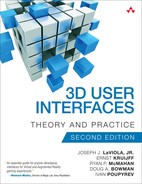PART III. Hardware Technologies for 3D User Interfaces
One way to describe human–computer interfaces is as a means of communication between a user (or users) and a system. The user must communicate commands, requests, questions, intent, and goals to the system. The system in turn must provide feedback, requests for input, information about the system state, and so on. We can think of this communication process as a series of translations. The user and the system do not speak the same language, so the interface must serve as a translator or intermediary between them. In fact, there are multiple translation steps involved (Figure III.1): the user first translates her goals into actions; next, the input device translates those actions into an electronic form for the system; finally, the system deciphers those signals based on the current system state. Typically, the system responds in some way to the input of the user, and so there must be some transformation of the input to produce the output—this is called a transfer function. To communicate this output to the user, the system translates the information into a digital display representation that is again translated by output devices into a form the user can perceive (e.g., light or sound), and finally, the user translates those perceptions into a meaningful semantic representation. The translations that occur between input devices and output devices are also known as control-display mappings.

Figure III.1 Human–computer communication through devices and translations.
In the end, though, all of this communication must use physical devices—hardware that serves as the medium of communication between the parties. This part of the book provides an overview of the hardware devices used to realize 3D UIs. Chapter 5, “3D User Interface Output Hardware,” covers output devices, which present or display information to the user’s perceptual system. Although visual displays are the most prominent type of output device for 3D UIs, we also cover auditory and haptic displays. Other displays including olfactory (i.e., smell) and gustatory (i.e., taste) have also been developed. In Chapter 6, “3D User Interface Input Hardware,” we discuss input devices—the means by which the user gives information to the system. The goal of these chapters is to give you an idea of the types of technologies commonly used in 3D UIs and to help you choose devices for your applications, not to provide an exhaustive survey of current devices or to discuss the design of 3D input/output devices.
